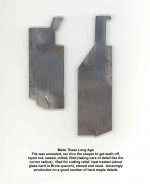Ross, that was awesome. I don't have a rotary table, but yes, I could make a sleeve! I'll keep my shop open for you anytime you need it in East Texas.

Something else you could fab.. when there is more time .. is a faceplate and drawbar to work woods off the BACK END of your metal-turning lathe's spindle.
Our school shop's wood turning lathe came already equipped for this. One classmate turned a rather large wooden salad bowl from glued-up laminate in contrasting light and dark wood.
He'd stand at the rear of the lathe, his graver over a floorstand tee rest.
There HAVE to be examples all over the wood-turning world, probably on YouTube as well, as this is a common need.
Page Two:
Wood needs respect, but in general the loads are easier to handle than they are for metals.
You don't need a "formal" rotab to manage this - not even for putting it on an angle.
Any "good enough", as-in low/no slop, axle and hub or bearing you can rig with a form of clamping to the mill table can work so long as loads are kept light, each go-round. I could grab one of the retired front hub spindles swapped-out off the Jaguar for this. It's actually a dirt-common Ford part, not just Jaguar, and many vehicles use similar ones. A flange drilled for bolts is on one end, the studs to mount brake rotor and wheel on the other. Decent bearings in between.
Both bandsaws and portable routers have been used as the "milling machine" with wooden jigs and simple shaft with a stock Oilite bushing - or sometimes for "onesies", just ignorant nails as "bearings". Time was, nearly every US State Governor and a whole lot more folks had a device in or near his office made with those tricks - around 40 of them from under my own hand. The "Autopen" signed his correspondence, mechanically. Their cases were wooden.
Now.. if only your mill was a horizontal.. some sort of faceplate, even if wood on a face-mill holder, and for shallow-long-axis woodworking - you have your large-swing "tee" lathe.

2CW





